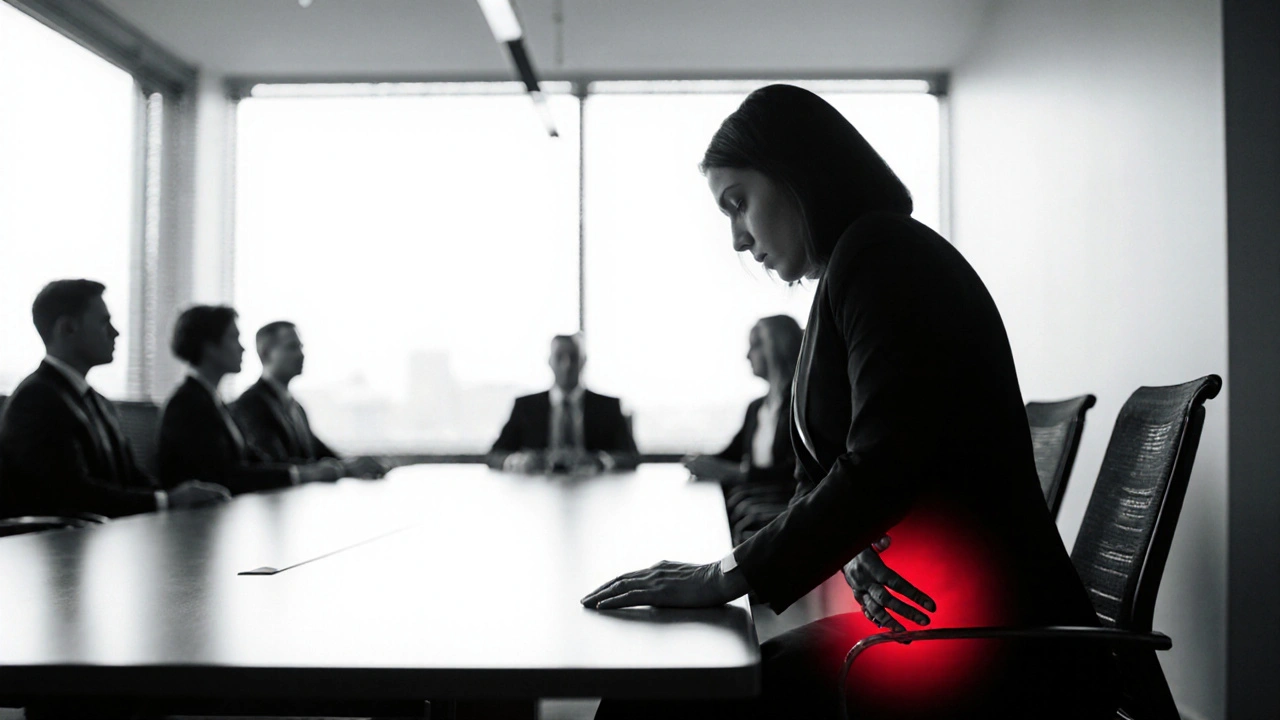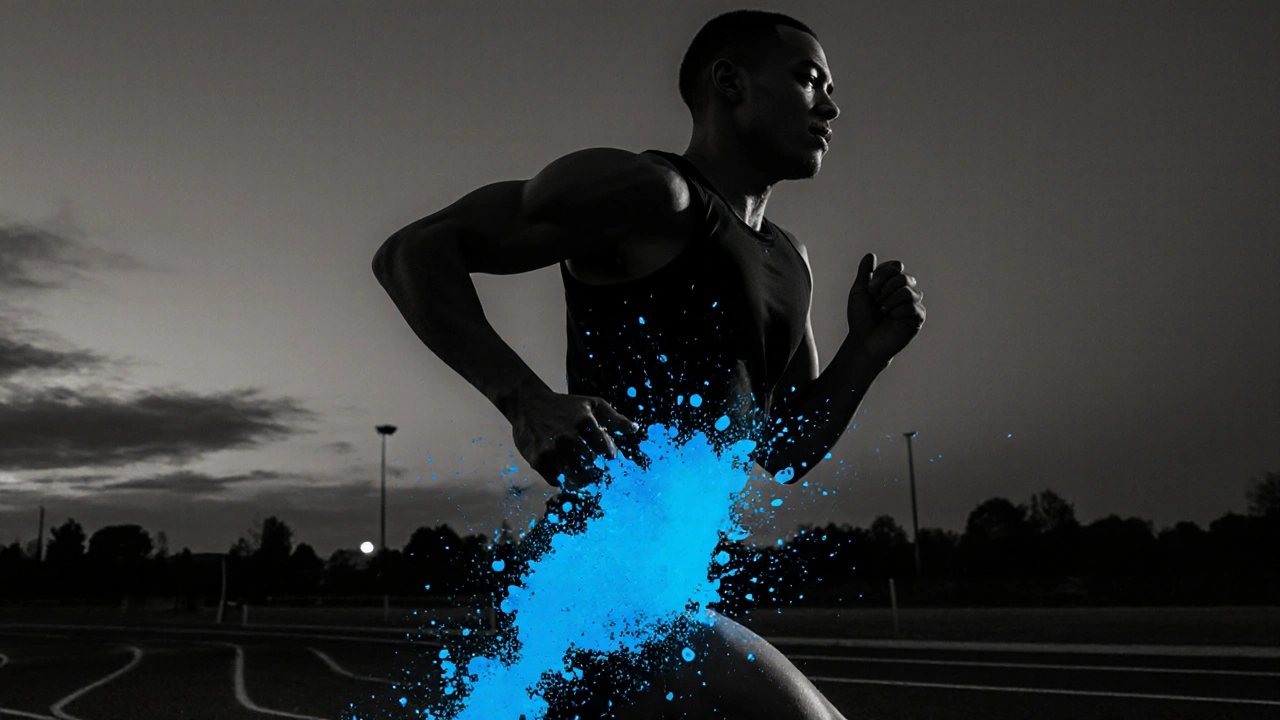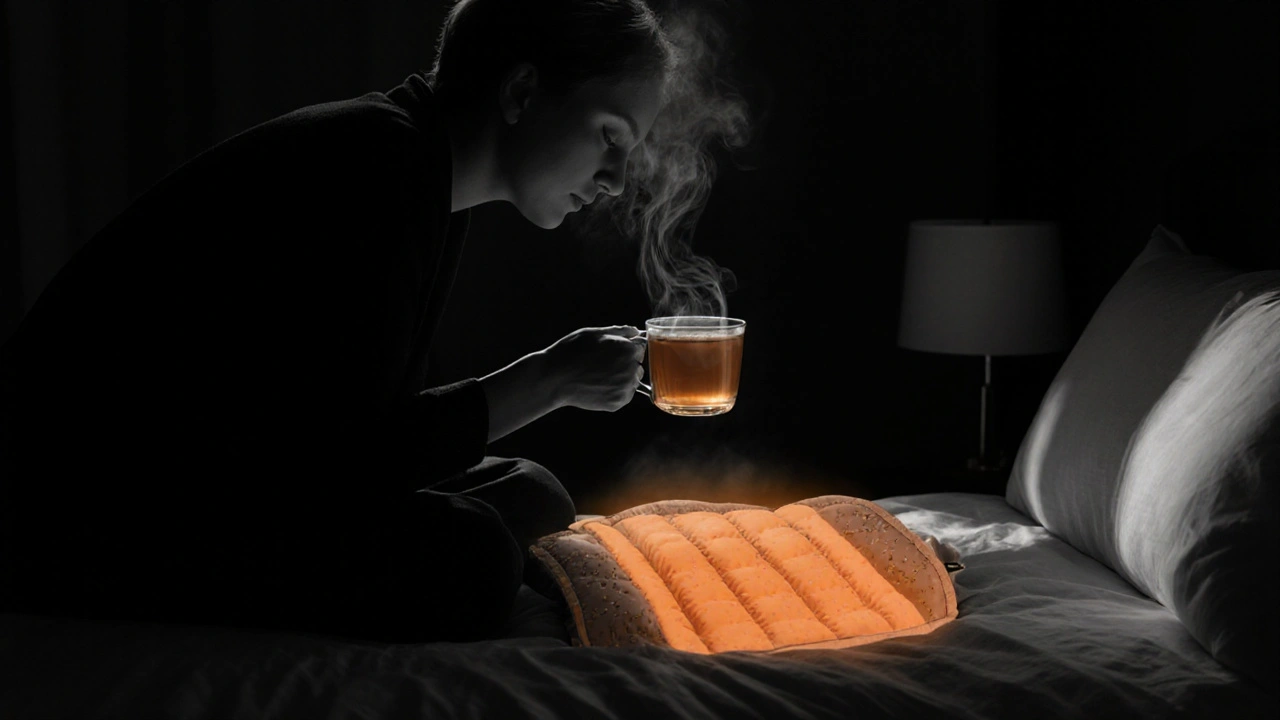 Oct, 16 2025
Oct, 16 2025
Bladder Spasm Trigger Calculator
This calculator estimates your risk of bladder muscle spasms based on common triggers identified in urology research. Answer the questions below to get your personalized risk assessment.
Ever feel the sudden, urgent need to rush to the bathroom in the middle of a meeting or while driving? That sharp, involuntary contraction of your bladder’s muscle is called a bladder muscle spasm - a brief, painful tightening of the detrusor muscle that forces urine out quickly. When these spasms strike repeatedly, they turn ordinary routines into constant guess‑work. Below we’ll walk through what the spasms feel like, how they creep into everyday tasks, and what you can actually do to get back some control.
What a Spasm Feels Like in Real Life
Imagine a sudden, electric jolt in the lower abdomen that makes you pause whatever you’re doing. For most people it lasts 5‑30 seconds, but the after‑effect - a lingering urgency - can linger for minutes. The feeling is often described as a "tightening" or "cramping" that forces a rapid stream of urine. Some report a constant low‑grade ache that builds up throughout the day, while others experience only occasional bursts.
How Daily Activities Get Interrupted
- Work: A sudden spasm can make it impossible to stay seated for long meetings. Many end up standing in the hallway or scheduling extra bathroom breaks, which can look unprofessional.
- Exercise: Running or high‑impact workouts increase intra‑abdominal pressure, often triggering a spasm right when you’re mid‑sprint. This can lead to reduced performance or stopped sessions.
- Travel: Long car rides, flights, or trains become stressful because you can’t predict when the next urge will strike. Limited restroom access magnifies anxiety.
- Social Life: Dinner parties or movies become a game of “who can hold it longest?” People may avoid gatherings altogether, leading to isolation.
- Sleep: Night‑time spasms cause frequent awakenings, leaving you exhausted and irritable the next day.
All these disruptions form a feedback loop - the stress of anticipating a spasm actually increases the likelihood of another one.
Common Triggers You Might Not Realize
Identifying what sets off a spasm is the first step toward managing it. Below are the top culprits, based on urology research from 2023‑2024.
- Caffeine: Even a single cup of coffee raises detrusor activity by up to 30%.
- Alcohol: It irritates the bladder lining, causing more frequent contractions.
- Carbonated drinks: The bubbles increase bladder pressure.
- Cold temperatures: Cold water can provoke a reflex spasm in some patients.
- Stress and anxiety: The nervous system and bladder share pathways; heightened stress amplifies spasm frequency.
Keeping a simple diary for a week - note what you ate, drank, and felt - often reveals a personal pattern.

How Doctors Pinpoint the Problem
If you haven’t yet, schedule a urology visit. The clinician will likely run a few standard checks.
- Urodynamic testing measures bladder pressure during filling and emptying, confirming involuntary detrusor contractions.
- Urine analysis rules out infections that can mimic spasms.
- Imaging (ultrasound or MRI) checks for structural issues like stones or tumors.
- Review of medical history for neurological conditions (multiple sclerosis, Parkinson’s) that can cause bladder hyperactivity.
These tests help differentiate a simple overactive bladder from more complex pelvic floor dysfunctions.
Treatment Options - What Works Best?
Below is a quick comparison of the most common interventions, drawn from the 2024 AUA guidelines.
| Option | How It Works | Typical Benefits | Key Side Effects |
|---|---|---|---|
| Anticholinergic meds (e.g., oxybutynin) | Blocks acetylcholine, reducing detrusor over‑activity | 30‑40% reduction in frequency | Dry mouth, constipation, blurred vision |
| Beta‑3 agonist (mirabegron) | Relax bladder muscle via beta‑3 receptors | Improves storage capacity, fewer nocturia episodes | Elevated blood pressure, headache |
| Botox injection | Paralyzes detrusor muscle locally | Long‑lasting relief (6‑12 months) | Urinary retention, need for intermittent catheterization |
| Lifestyle changes | Reduce triggers, timed voiding, pelvic floor exercises | Often enough to cut episodes in half | Requires consistency, initial learning curve |
| Neuromodulation (sacral nerve stim) | Electrical impulses modulate bladder reflexes | High success in refractory cases | Surgical risks, device malfunction |
Most doctors start with the least invasive option - lifestyle tweaks and timed voiding - before moving to medication. If meds fail or cause intolerable side effects, Botox or neuromodulation become viable next steps.
Practical Day‑to‑Day Management Tips
- Timed voiding: Set a schedule (every 2‑3hours) regardless of urge. Over time, your bladder learns a new rhythm.
- Pelvic floor training: Simple Kegel exercises strengthen the muscles that control urine flow. Aim for three sets of 10 contractions daily.
- Hydration balance: Drink enough to avoid concentrated urine (which irritates the bladder) but don’t overfill. Aim for 1.5-2L water spread across the day.
- Limit irritants: Cut back on caffeine, alcohol, and artificial sweeteners. Replace soda with infused water or herbal tea.
- Heat therapy: A warm pad on the lower abdomen can relax the detrusor muscle during a spasm episode.
- Mind‑body techniques: Deep breathing, progressive muscle relaxation, or guided imagery reduce stress‑induced spasms.
Integrating these habits gradually - for example, start with hydration, then add timed voiding - makes the routine sustainable.

When to Call a Healthcare Provider
If you notice any of the following, schedule an appointment promptly:
- Bleeding or blood in urine
- Fever or chills (possible infection)
- Sudden increase in frequency (more than 8 times per day)
- Inability to fully empty the bladder
- New onset of symptoms after a fall or injury
Early evaluation can prevent complications like urinary retention, kidney damage, or chronic pain syndromes.
Quick Checklist - Keep It Handy
- Track triggers in a diary for 7days
- Schedule bathroom breaks every 2‑3hours
- Practice Kegels three times daily
- Limit caffeine to <1cup per day
- Stay hydrated - 1.5‑2L water
- Contact your doctor if you see blood or fever
Frequently Asked Questions
What’s the difference between a bladder spasm and a urinary tract infection?
A spasm is an involuntary muscle contraction without infection, while a urinary tract infection (UTI) involves bacterial growth, often causing pain, foul‑smelling urine, and fever. A urine test can differentiate them.
Can stress really cause bladder spasms?
Yes. The bladder receives signals from the sympathetic and parasympathetic nervous systems. When you’re anxious, the parasympathetic tone can increase, prompting the detrusor muscle to contract more often.
Is it safe to use over‑the‑counter anticholinergics for occasional spasms?
OTC options exist, but they still block acetylcholine and can cause dry mouth or constipation. Always check with a clinician, especially if you have glaucoma or heart issues.
Do pelvic floor physical therapists help?
A trained therapist can teach you precise Kegel techniques, biofeedback, and relaxation strategies that target the muscles responsible for spasms. Many patients see a 30‑50% reduction in episodes.
When is Botox recommended?
Botox is usually considered after medication fails or side effects are intolerable. It offers long‑lasting relief but requires a urologist to inject the detrusor muscle and monitor for urinary retention.
Amy Aims
October 16, 2025 AT 13:36Wow, bladder spasms can really hijack a day, but you’re not alone in this battle 😊. Keeping a simple diary is a game‑changer; it shines a light on hidden culprits like that sneaky soda you love. Pairing timed voiding with a few gentle Kegels each morning can slowly retrain the muscle without drama. Remember to stay hydrated, but don’t feel guilty if you need to sip water more often – your body’s sending you clues. You’ve got the tools, just take them one step at a time!
Shaik Basha
October 23, 2025 AT 13:36Man, i totally get the stress – i once had to bail out of a long meet because my bladder went full rebel mode. Caffine + cold water is like a combo‑attack, lol. Just try ditching the fizzy drinks for a week, you’ll notice the difference quick. Also, put a reminder on your phone for bathroom breaks, saves a lot of awkward runs. Stay chill, bro!
Quinn S.
October 30, 2025 AT 12:36While the article presents a commendable overview, it egregiously omits critical discussion of the adverse cognitive effects associated with anticholinergic therapy, a glaring oversight. The recommendation to initiate lifestyle modifications without quantifying efficacy lacks empirical rigor, rendering the guidance superficial at best. Moreover, the assertion that “most doctors start with the least invasive option” is not universally substantiated across differing healthcare systems. A comprehensive, evidence‑based hierarchy of interventions should replace such vague statements. The omission of cost‑benefit analyses further undermines the article’s utility for informed decision‑making.
Dilip Parmanand
November 6, 2025 AT 12:36Start with a clear schedule-every two hours, no matter what. It conditions the bladder and reduces surprise attacks. Add a quick 5‑minute pelvic floor routine after each void. Consistency beats intensity every time.
Sarah Seddon
November 13, 2025 AT 12:36Picture this: you’re the captain of a ship, and each bladder spasm is a sudden wave threatening to capsize your day. By charting your triggers like a seasoned navigator, you can steer through caffeine reefs and alcohol storms with confidence. The timed‑voiding plan is your compass, while Kegels are the sturdy sails that catch the gentlest breezes. Embrace the routine, and soon the chaos will feel like a distant memory, replaced by smooth sailing.
Tatiana Akimova
November 20, 2025 AT 12:36Cut the caffeine, cut the chaos.
Dan Burbank
November 27, 2025 AT 12:36It is a veritable tragedy that modern civilization, in its relentless pursuit of productivity, has relegated the humble bladder to a peripheral concern, yet the ramifications of its dysfunction echo loudly across the tapestry of daily existence. One must first acknowledge that the detrusor muscle, akin to a finely tuned orchestra, can be thrown into dissonance by the most innocuous of external stimuli-caffeine, carbonation, even the chill of a winter’s breeze. The article under consideration commendably enumerates these culprits, but it stops short of interrogating the sociocultural forces that predispose us to such irritants, namely the ubiquitous espresso culture that pervades corporate settings. Moreover, the proposed interventions, while clinically sound, suffer from a paucity of personalization; a one‑size‑fits‑all regimen disregards the nuanced interplay between neurogenic pathways and individual lifestyle. In the realm of pharmacotherapy, the anticholinergic class is painted with a broad brush, yet the specter of cognitive decline, especially in geriatric populations, warrants a more circumspect appraisal. Mirabegron, the beta‑3 agonist, is lauded for its bladder‑relaxing properties, but its hypertensive potential cannot be relegated to a footnote. The discussion of Botox, though thorough, neglects the ethical quandary of rendering a muscular organ temporarily inert, thereby inviting dependence on intermittent catheterization. Neuromodulation, the pièce de résistance for refractory cases, is heralded without acknowledgment of the financial and surgical barriers that confine its accessibility. From a behavioral standpoint, the article’s emphasis on “timed voiding” is laudable, yet the absence of data on adherence rates renders the recommendation somewhat aspirational. Pelvic floor training, a cornerstone of conservative management, would benefit from a delineated progression schema-starting with diaphragmatic breathing and culminating in resisted contractions. The suggestion to balance hydration is sound, but the concept of “optimal urine concentration” remains vague without quantitative guidance. Finally, the psychosocial dimension-stress as both catalyst and consequence of bladder spasms-is introduced but not explored with the depth it deserves. Cognitive‑behavioral strategies, mindfulness, and even biofeedback could serve as adjuncts, weaving a holistic tapestry of care. In summation, while the piece furnishes a solid foundation, it languishes in the realm of superficiality, yearning for the rigor and nuance befitting a condition that so profoundly disrupts the human experience.
Anna Marie
December 4, 2025 AT 12:36Dan, your comprehensive critique certainly elevates the discussion, and I concur that a deeper exploration of socioeconomic barriers would enrich the narrative. Incorporating patient‑reported outcomes alongside the clinical data could also provide a more balanced perspective. Thank you for highlighting these gaps.
Abdulraheem yahya
December 11, 2025 AT 12:36Observing how bladder spasms infiltrate the rhythm of everyday life feels akin to watching a subtle tide that gradually reshapes the shoreline. When the urge strikes during a marathon Zoom call, the mind oscillates between focus and the primal need to find relief, creating a cognitive dissonance that saps productivity. The article’s practical tips-timed voiding, pelvic floor exercises, and mindful hydration-act as anchors, offering stability amidst this internal turbulence. Yet, the true mastery lies in integrating these strategies seamlessly, so they become second nature rather than burdensome tasks. Over time, the body learns to anticipate and modulate the detrusor’s over‑reactivity, transforming a once‑intrusive symptom into a manageable rhythm of the day.
Preeti Sharma
December 18, 2025 AT 12:36One might argue that the preoccupation with eliminating every bladder spasm reflects a deeper cultural denial of bodily imperfection, privileging control over acceptance. If we reframe these episodes as signals rather than failures, we could cultivate a more compassionate relationship with our physiology. In this light, the relentless pursuit of pharmacologic suppression may mask an opportunity for introspection and holistic growth.